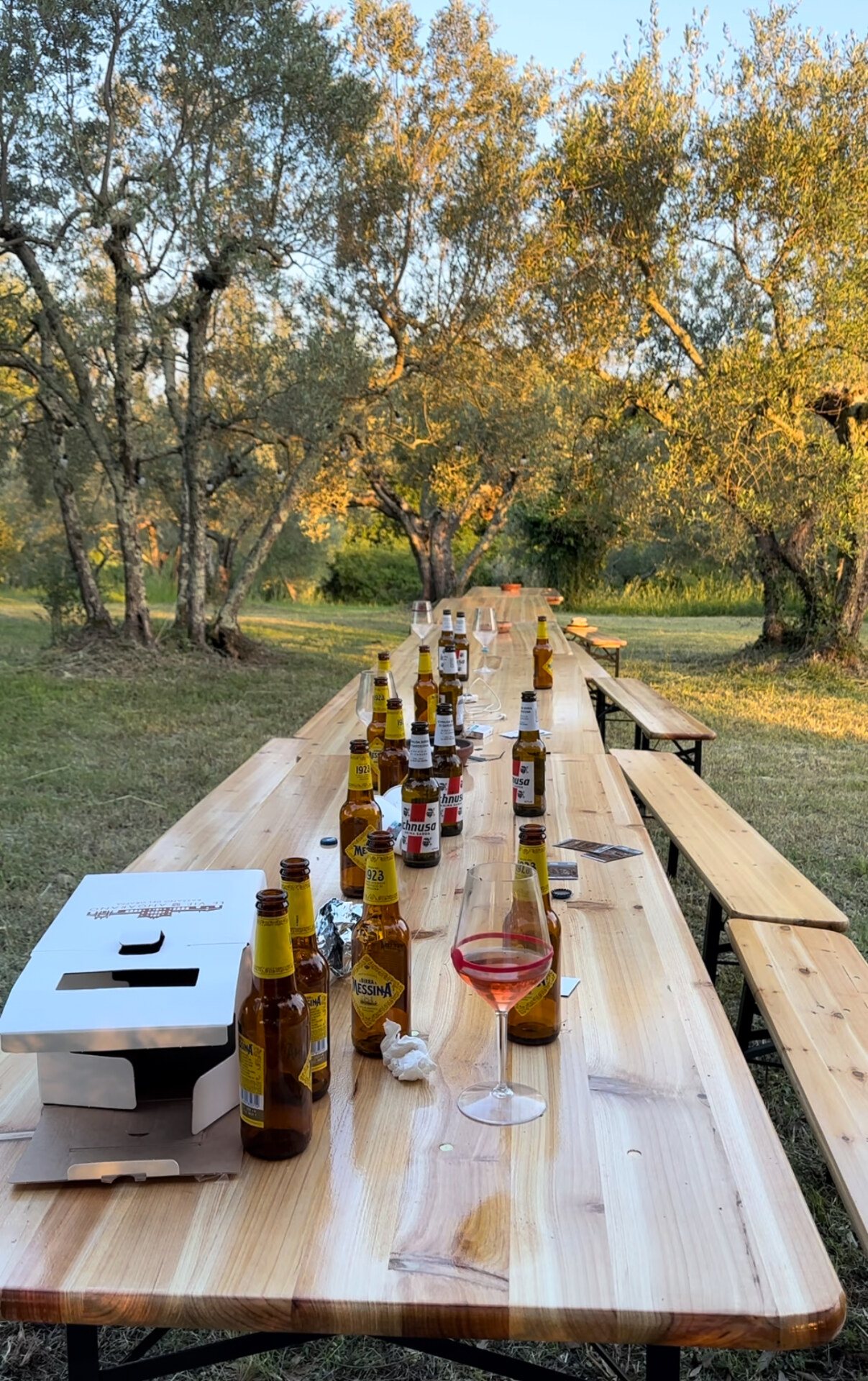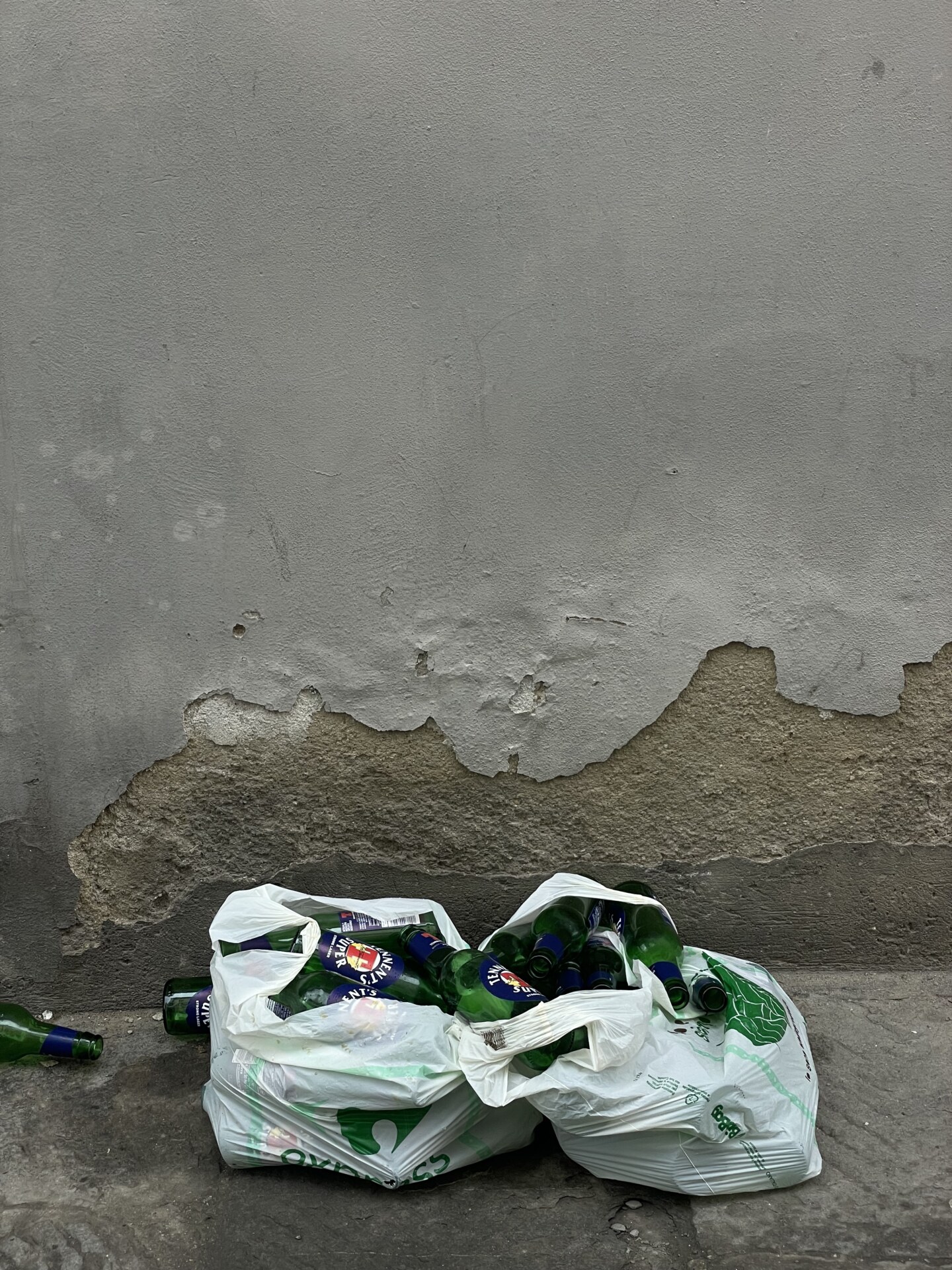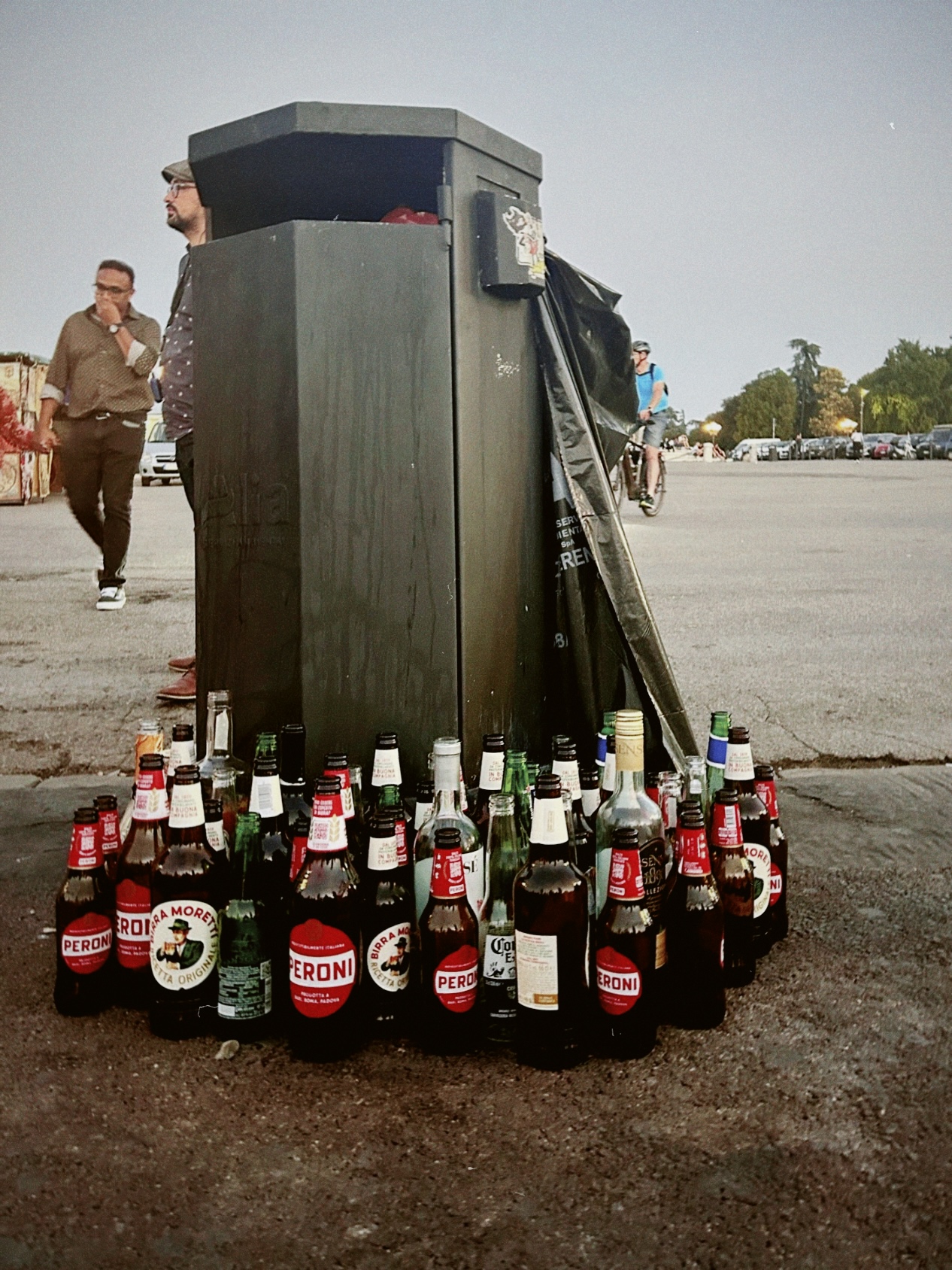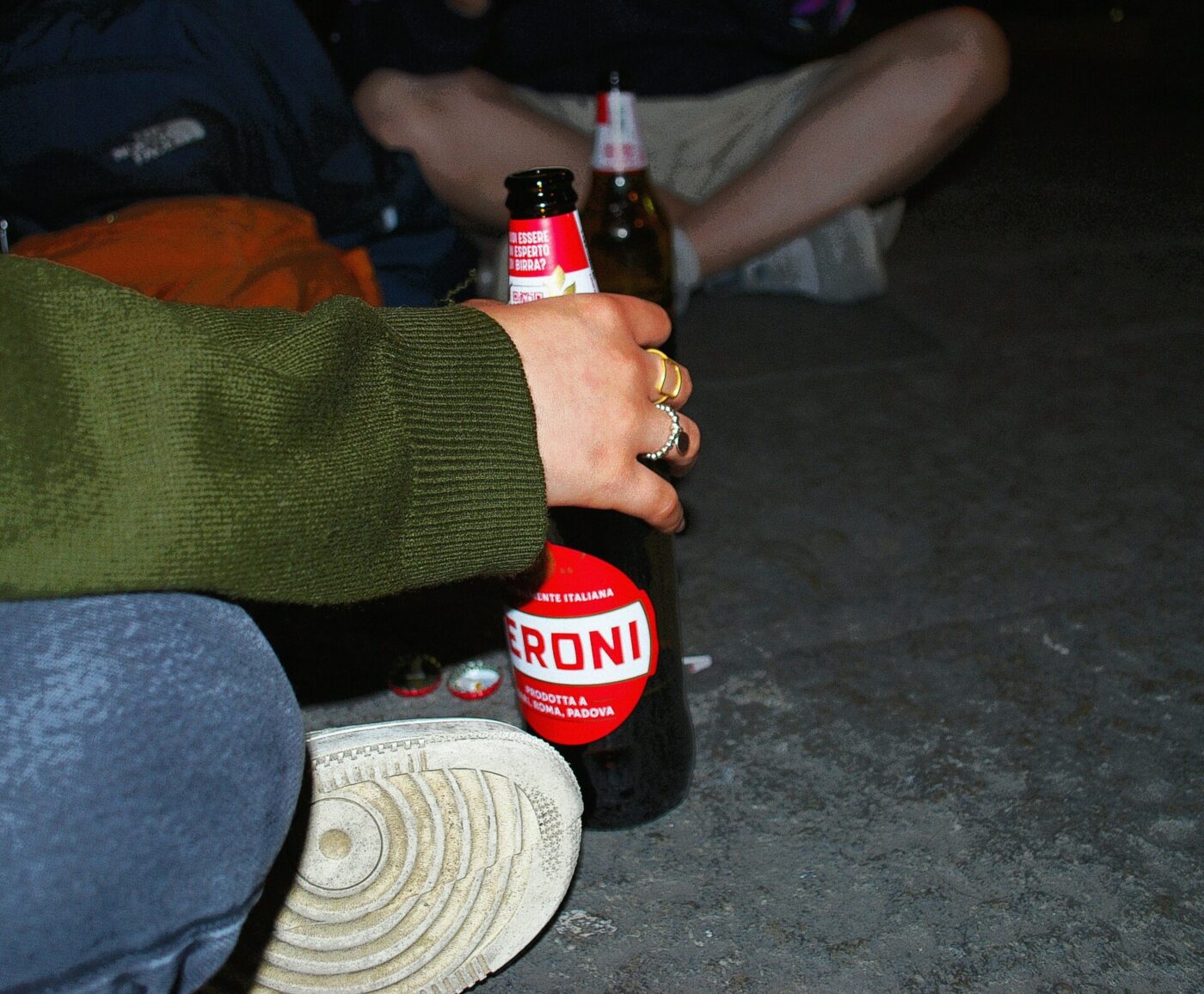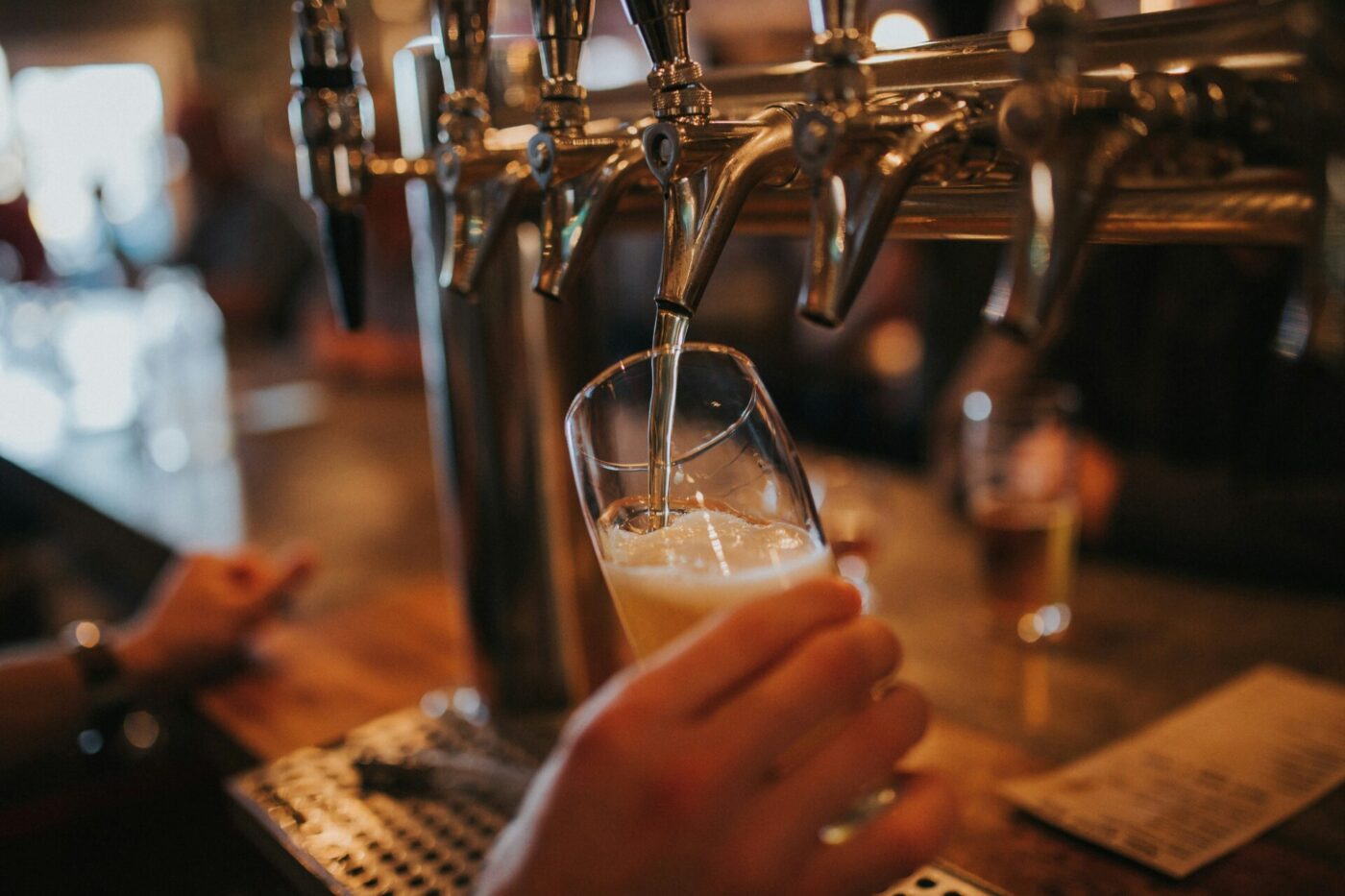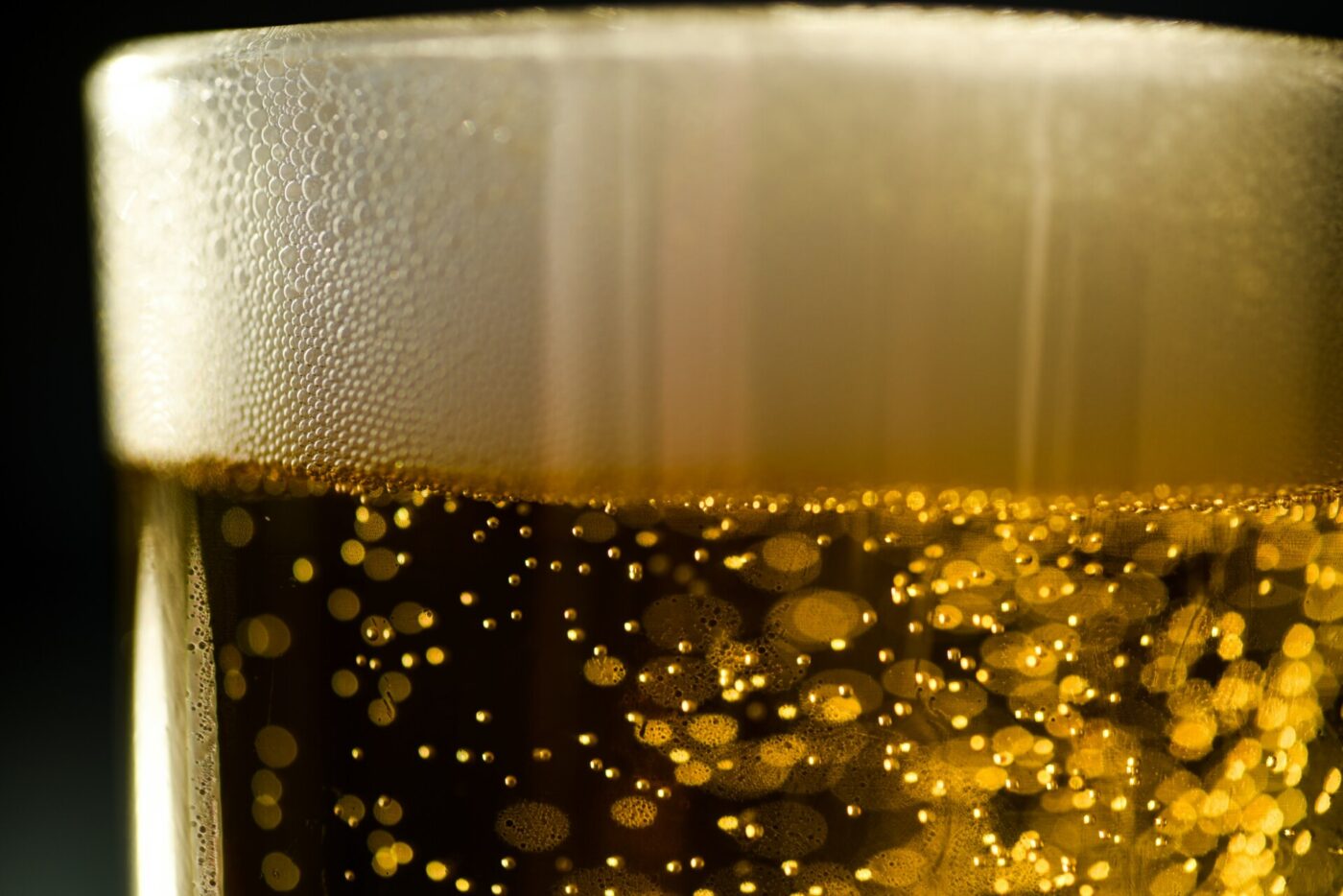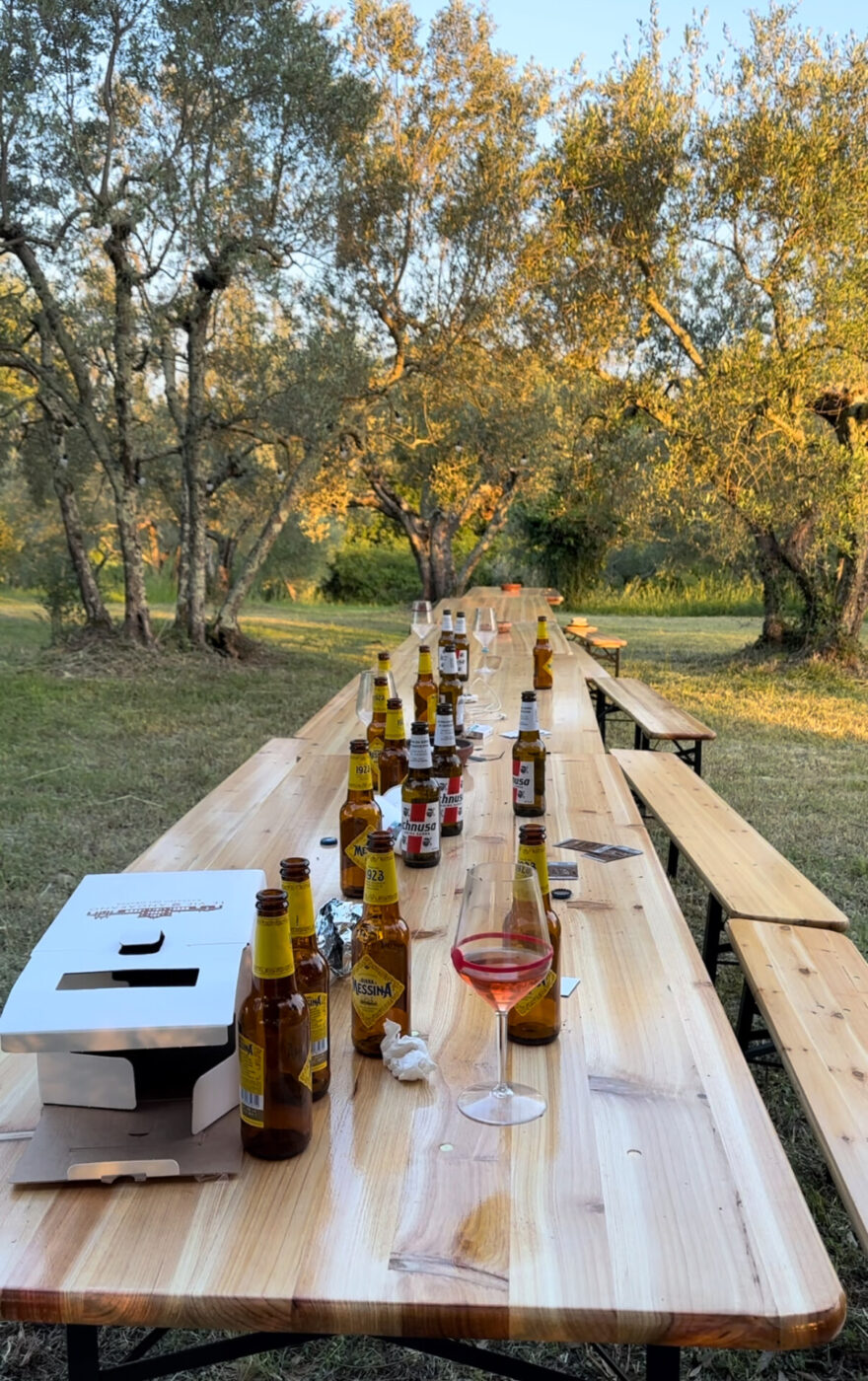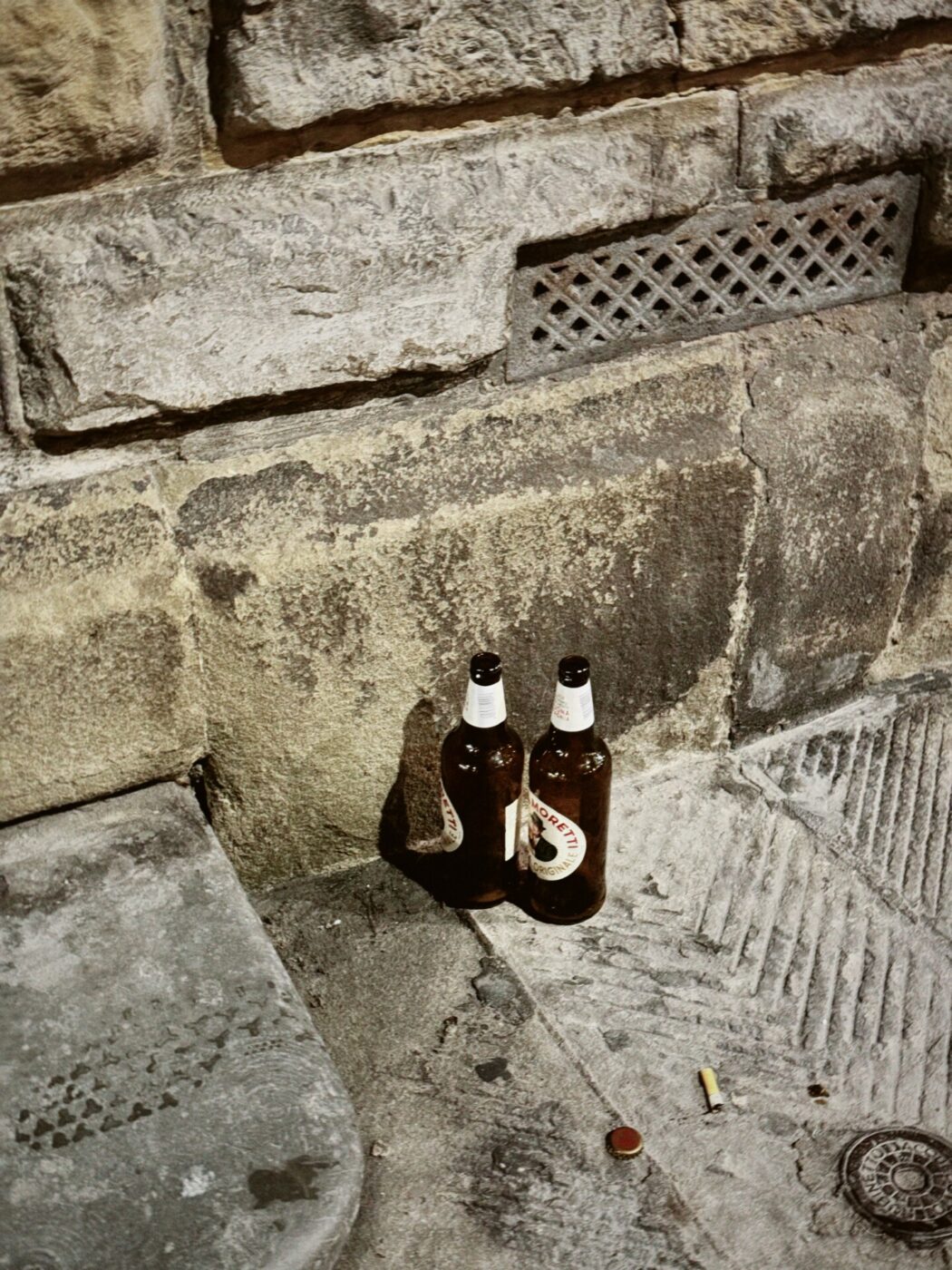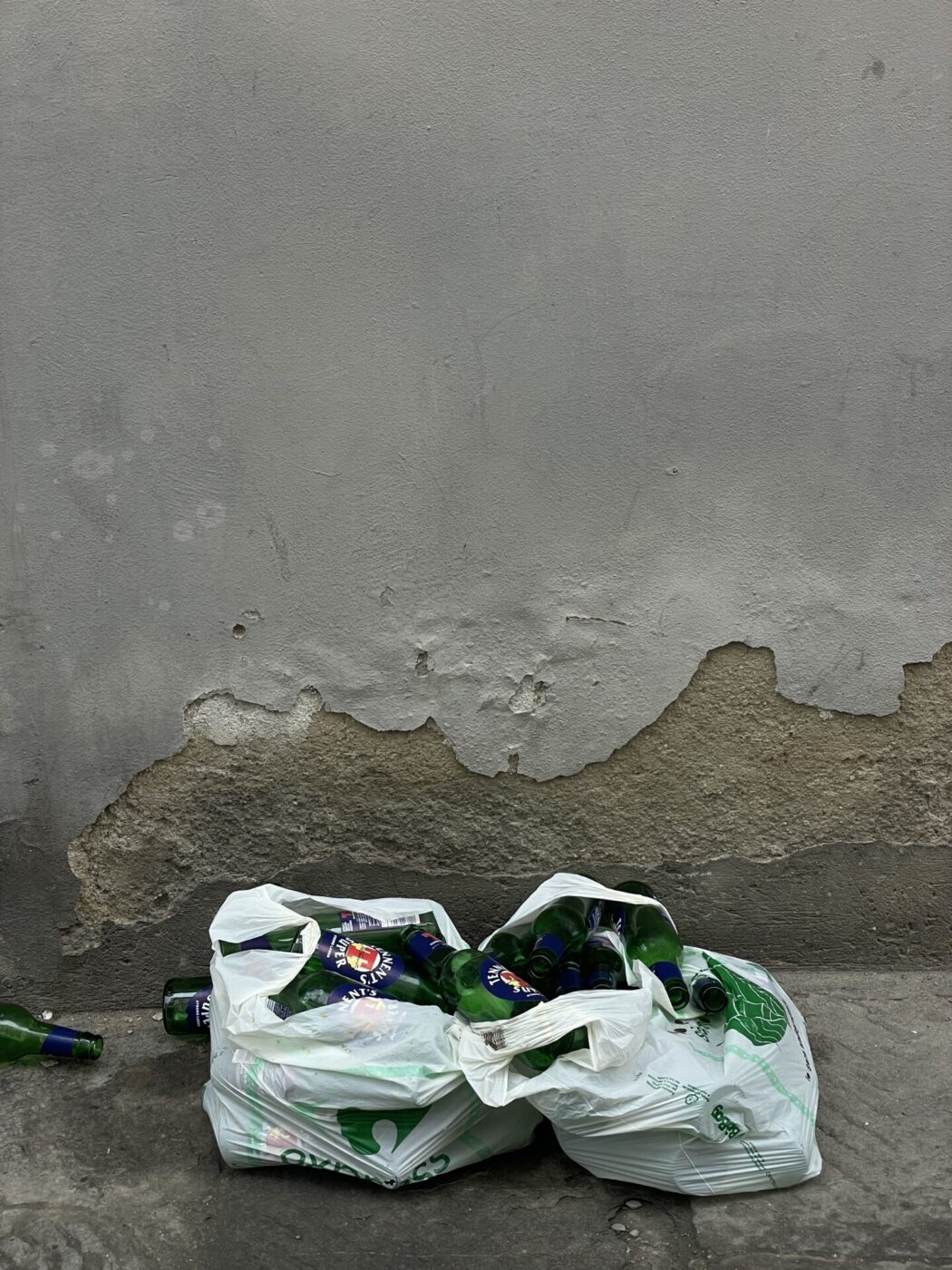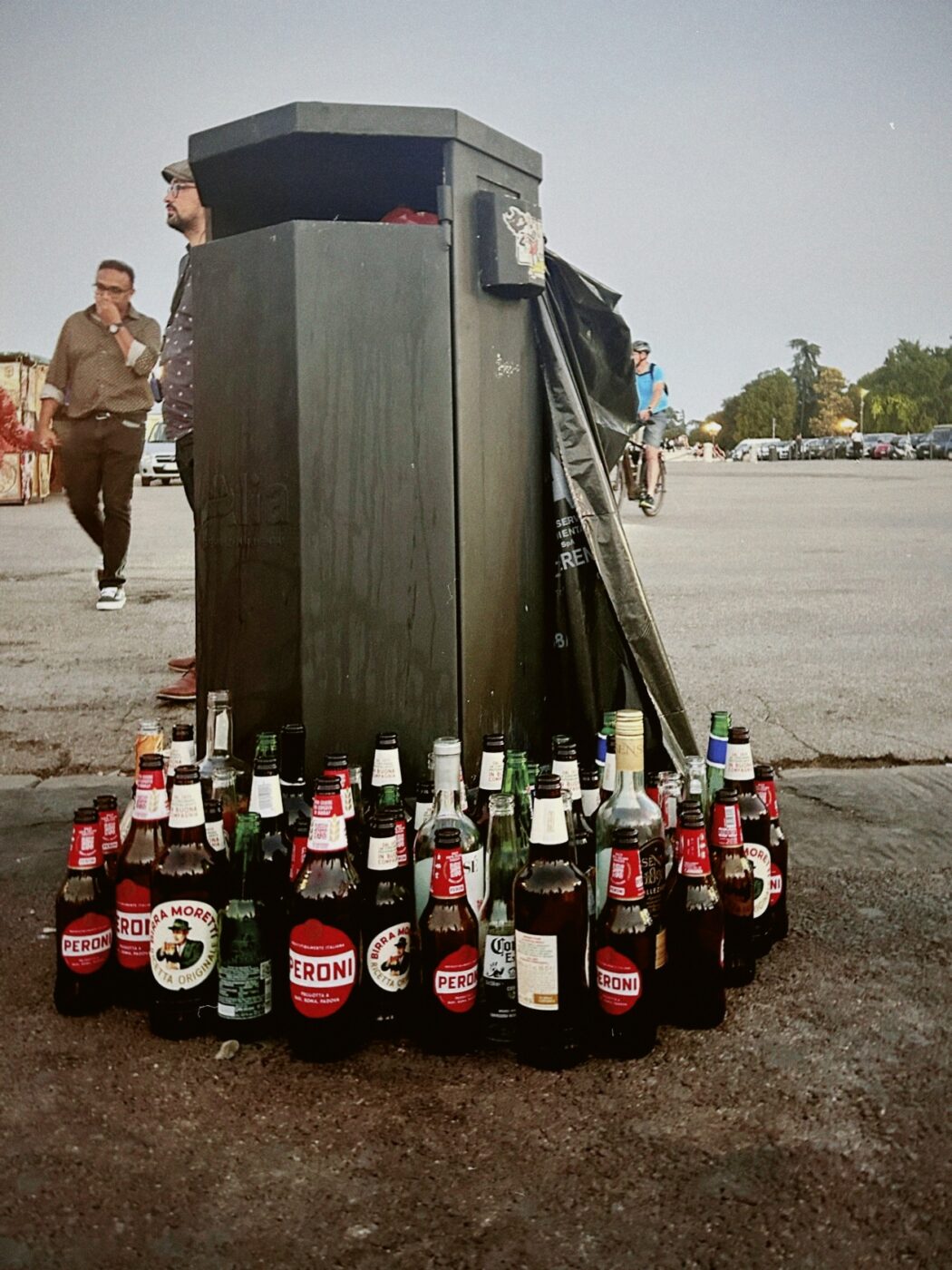Shards of broken beer bottles crunch under my feet while I walk through Trastevere en route to the market, early Saturday morning. Tennet’s Super Strong Lager, a Scottish beer, is higher in alcohol than the classic Italian lager, and most teenagers who drink this beer tend to prefer the buzz to the taste. Why the empty bottles are left unattended, and not disposed of at the end of the night, I’ll never understand. The broken glass adds to the mosaic of the city streets, filling in the spaces between the cobblestones.
Neon Birra Peroni signs glow through the window of le trattorie and i bar around Rome. The iconic branded lettering and burnt red color scheme seen on tables, umbrellas, and blackboard menus are quintessential to the aestheticism of Italy.
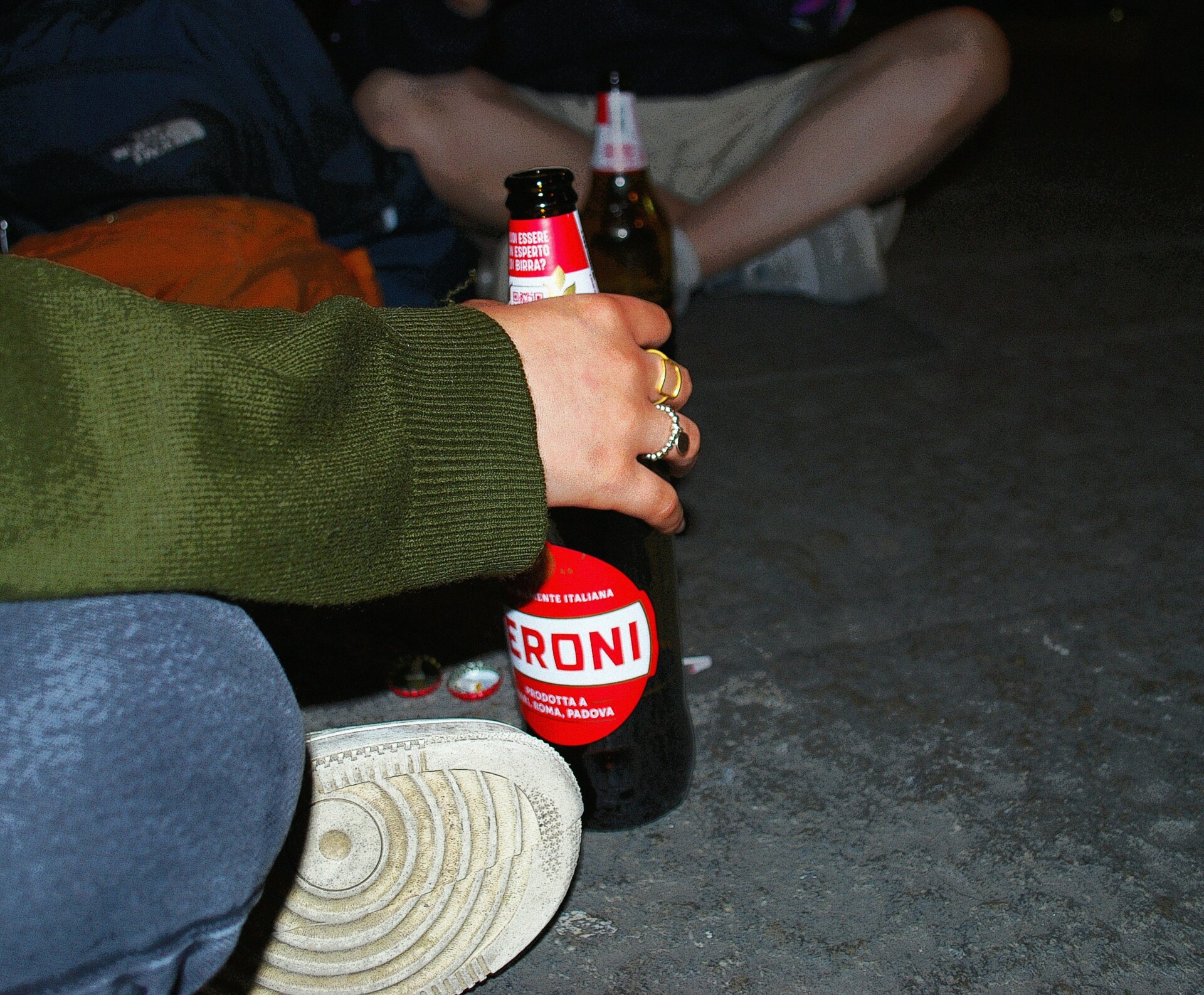
Contrary to the marketing tactics of certain wine brands, wine is not the beverage of choice with la pizza. As Italians are infamously concerned about their digestion, the only beverage suitable with such a pesante meal, is a carbonated beverage, la birra. Walk into any pizzeria in Rome and you will see a bottle of Aqua di Nepi and a liter of Menabrea being passed around.
There’s comfort in familiarity–that’s what industrial Italian beer provides. Every train station throughout the country stocks their bar with cold bottles of light lager. An Italian light-lager, a dark roast espresso; there’s no need for clarification. Despite the 30 years of effort, will birra artigianale ever have the same recognizable cache as these classic brands filling the fridges and draft lists of every bar in Italy?
It’s not until 1996 that the craft beer movement began in earnest in Italy–inspired by American trends and the openings of a few industry pioneers, Milan’s Birrificio Lambrate among them–and it wasn’t until 2003 that it really took off–relatively speaking, that is. Craft beer can hardly compete with the globally recognized brands that give a sense of authenticity and nationality here. One would think that, in an effort to honor and live by the “slow” and inherently sustainable characteristics of Italian life, more people would endorse birra artigianale.
The craft beer industry supports local food economies and small business owners, and there’s even a Slow Beer Guide, under the Slow Food umbrella, which highlights the brewers and breweries that work as artisans not as manufacturers. Many craft breweries in Italy source local ingredients, such as hops, barley malt, fruit, and spices. Loverbeer’s Birra Brugna, a Belgian Kriek-inspired beer, is a sour ale brewed with Ramassin, a damask plum under the Slow Food Presidium. Birra Nazionale by Birra Baladin is an 100% Italian craft beer, with all ingredients sourced from Italy: water from the Maritime Alps, barley malt from their own fields in Basilicata and Puglia, and hops grown in Piedmont. Which is more Italian? Craft beer, brewed at a small brewery in the countryside, or a mass-produced beer whose label is owned and managed by a global enterprise?
Some may argue that Birra Peroni is Made in Italy, technically in Rome, Padua, and Bari, and brewed with 100% Italian grown malt. Peroni seems like a beer for Italians, made by Italians. But climb the corporate ladder a bit higher and you’ll find that Peroni is, in reality, a large conglomerate owned by an even larger, non-Italian brand (Asahi Breweries).
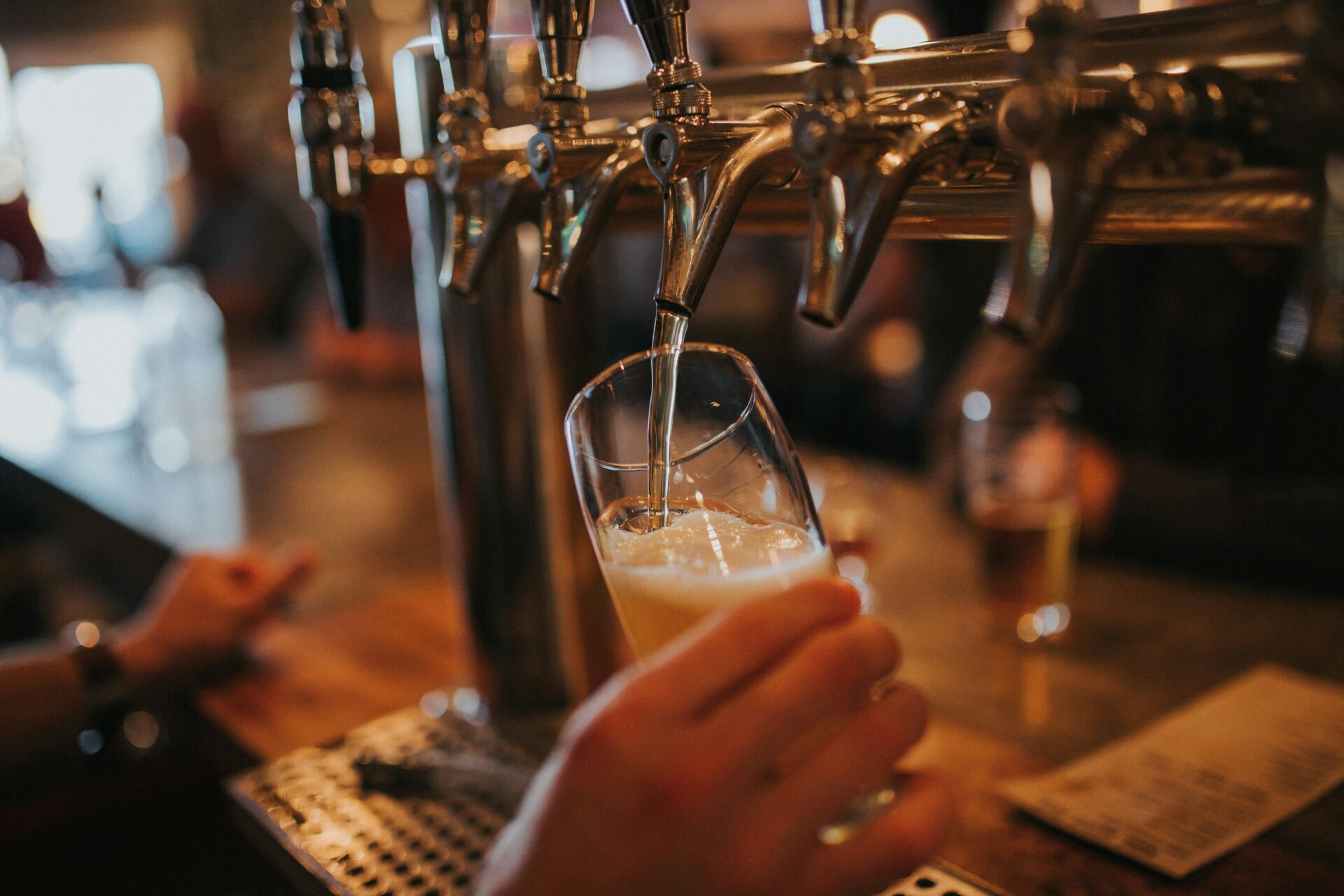
At an institutional beer bar, not so tucked away on one of Trastevere’s main drags, birra artigianale is always on draft; it’s the only thing on draft. Ma Che Siete Venuti a Fà, championed the craft beer movement over 20 years ago, yet it remains a humble dive, playing the music they want and pouring what they want, in the best way possible. On even the coldest nights of January, long-time patrons, Roman millennials, and tourists who did their research huddle in groups outside. There are nebulous clouds of cigarette smoke, making it nearly impossible to see the pizzeria across the street. Tables outside, with stickers that read “locals only” only make passersby more intrigued. The winter air is cold, but patron’s hands act like koozies, regulating the temperature of the beer in their glass. Craft beer isn’t exactly served “cold”, rather at just above room temperature to allow for more subtle flavors and perfumes to shine through–similar to white wine served at cellar temperature as opposed to fridge temperature. Cold, even ice cold, beer is an industrial trick; the cold makes the carbonated beverage more appealing and distracts the consumer from the lack of flavor. Craft, on the other hand, is served just about room temperature. Beers from Germany, Belgium, and around Italy are constantly in rotation, but the favorites remain. Many nights I sat alone and found company after a pint or two. I was known as the girl who ordered the Gallagher Stout on pump and Irish ale brewed with smoked seaweed from a birrificio called Hilltop in Bracciano.
Ma Che Siete Venuti a Fà acted as my refuge when I first moved to Rome. I met my boyfriend at this pub; he introduced me to the Italian craft beer world and showed me a side of Italian culture I didn’t know existed. It was Italian beer, not wine, that cured my self-doubt when I was alone in Rome during the throes of August. It was the beverage of choice after a long day of picking grapes during harvest. Beer has taught me how to enjoy the pauses, but it was craft beer that inspired my journey towards living a more sustainable lifestyle, and making choices that supported a more equitable, sustainable food system in Italy.

Craft beer in Italy is thriving, but you’ll have to seek it out. Here’s how to do so in Rome.
Where to Drink Craft Beer in Rome:
BARS
Ma Che Siete Venuti a Fà – One of the most historic beer bars in Europe, known as Macchè for short. They always have a rotating tap list of artisan beers made in Italy, Germany, and elsewhere.
L’Elementare – This pizzeria is host to another great tap list and one of the few establishments with a bar inside where guests can sit down and eat a full meal. You also can order a pizza or supplì for takeaway and enjoy a few slices while drinking outside Macchè.
Luppolo Station – Luppolo means “hops” in Italian, and this is a great place to grab a burger, have a cold beer, and, when in season, watch football on the big screen. Check their Instagram for live music nights.
Open Baladin – The perfect beer bar and gastropub to refuel and refresh after a long walk through the center, as it’s less than a mile from Piazza Venezia, Campo de’ Fiori, and The Jewish Quarter.
Les Vignerons – Les Vignerons is technically a wine shop, but it has a fully stocked fridge for craft beer and a whole wall dedicated to sours, including wild ales, lambics, goses, and many others. The owner, Antonio, has curated a store with some of the best natural wines and craft beers available in Europe. I usually grab Mukkellerina, a German Helles inspired beer from Mukkeller, a brewery near the Adriatic Coast side of Italy, and Friend Zone, a Saison brewed in collaboration from MC-77 and Hilltop Brewery.
Johnny’s Off License – A wine and craft beer shop with a wide selection of whiskey, gin, and spirits close to Tuscolano Nord.
So Good! – A hidden refuge on a hot Roman summer day, just a few minutes from Circo Massimo. The tap list is small but crafted.
Artisan – This is the best beer bar in the San Lorenzo neighborhood. Industrial vibe, with large garage-like doors open for easy access to smoke breaks. Open late.
Be.Re. – The beer king is a stone’s throw from the Vatican Museums and a great place to stop for a cold beer and a trapizzino.
Beer Time – Not-yet-a-dive craft beer bar with a patio facing Piazza di Quiriti.
BREWERIES
Jungle Juice Brewery – That’s right, a brewery and taproom in Rome. Jungle Juice fully opened in 2016, making beer for bars around the city and boasting a tasting room which offers beer and food. You can also book a guided tour of the brewery.
Hilltop Brewery – Since 2014, brewer Conor makes quality craft lagers and ales that are well worth the drive. Hilltop beers also grace the tap lists of other establishments around the city. “When in Doubt Drink Gallegher Stout” is a theme at many craft beer pubs in the city.
Rebel’s Brewery – A brewery, taproom, and summer garden in southern Rome where West Coast, Session, and New-England style IPAs are freshly brewed. Beers are available on draft at the brewery and widely available throughout the city on draft or in cans.
Ritual Lab – Ritual Lab won Brewery of the Year in 2020 at Birraio dell’Anno, and Giovanni won best brewer in 2021. After completing culinary experiences abroad Giovanni’s brother, Matteo joined the team. Together they have Mogano, a restaurant recognized by the Michelin guide, that proves there is space for beer pairing in elevated cuisine. The tasting room and restaurant are on-site.
Vento Forte – In Bracciano, just outside of Rome, this brewery in green surrounds specializes in West Coast IPAs and Pale Ales.
